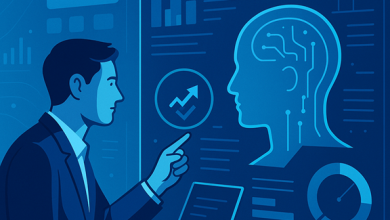
It’s been a long time since the world watched in awe as Neil Armstrong stepped foot on the moon.
TV screens showed grainy black-and-white images of Armstrong bouncing onto the lunar surface.
In the almost six decades since, TVs have got a lot better, and so more recently, has space travel.
But the energy infrastructure which powered those TVs and the space program which created the Apollo 11 mission is still largely the same and it’s creaking under the demands of the modern world.
Meanwhile the planet – captured as a vibrant, blue marble from space – is more fragile than ever. And so is our energy system.
For the last 20 years, electricity consumption across the OECD has remained more or less stable. Now, it’s increasing, and keeping pace with growing global demand whilst transitioning to a broader generation mix requires a level of agility that traditional systems simply cannot provide.
Enter artificial intelligence, an essential catalyst for transforming every aspect of the energy industry, from source to end-user.
Historically, the grid operated in a one-way consistent flow: large power plants generated electricity, and utilities distributed it to consumers, who consumed it consistently.
The rise of volatile renewables – mainly solar and wind, combined with grid-scale battery storage – alongside the rise of distributed energy resources (DERs), with the fluctuating demand patterns and significant charging spikes associated with EVs, have turned the current model on its head.
Rather than relying on an outdated, static grid, AI can create a balanced, dynamic energy system – one that can integrate those clean but intermittent renewables like wind and solar without compromising stability.
The technology has arrived just in time, as projected costs for the required expansion of transmission infrastructure under our current energy system are eye-watering. Instead, AI allows us to make fuller use of the infrastructure we have. By coordinating and managing dispatch and demand in real-time, AI flattens demand peaks and helps balance the grid.
Businesses leaning into the new capabilities will benefit from a competitive advantage.
For example by analysing real-time and historical trends, data-driven companies can predict energy demand spikes and optimise supply strategies.
A good example of this in action is when it comes to electric vehicles. AI can dynamically shift EV charging to when electricity prices are lowest – usually at night – and then dispatch energy from car batteries onto the grid to support during peak hours. AI can coordinate this dynamically across an entire energy system, in a way human hands could not.
Mass adoption of this flexible approach would avoid the need to deliver the energy transition via “brute force” – by building the generation and transmission infrastructure designed to meet peak demand under the status quo.
In the UK, for example, the average home uses about 8 kWh per day and a Tesla Model S, with a 95 kWh battery, could power a home for 11 days.
Bidirectional charging managed by AI enhances grid reliability but also drives down costs as well as opening up new revenue streams for utilities and households.
A glance at news from around the globe shows us that energy markets are more volatile than ever. From extreme weather events in places like Texas disrupting supply, to geopolitical uncertainties affecting fuel prices, the industry is constantly navigating unpredictability. AI-driven forecasting models are helping utilities anticipate and mitigate these risks.
And while AI is reshaping the physical infrastructure of the energy sector, it is also redefining how utilities interact with their customers.
Traditionally, utilities have been slow-moving, trying to balance innovation with risk management, struggling with customer service costs and outdated communication models. Today generative AI is changing that too, enabling utilities to serve customers up to 40% more efficiently.
AI-powered chatbots, virtual assistants, and automated billing systems are streamlining customer interactions, reducing response times, and eliminating administrative bottlenecks. Whether it’s helping customers optimise their energy usage, providing instant support for billing inquiries, or proactively alerting consumers about outages, AI-driven automation is enhancing customer satisfaction while cutting operational costs.
It is clear the benefits of AI adoption are vast, but it’s important to acknowledge the impact of the energy needed to power it. One study warned that the industry could consume as much energy as a country the size of the Netherlands by 2027.
Companies must measure the impact of their AI usage and ensure it has a negative footprint, but AI can also contribute to reducing it too.
By optimising energy consumption at large data-centres, it is possible to run functions which are not time-critical at night, for example, when energy is more abundant and cheaper.
Domestic consumers already do this with their EVs and it’s entirely possible for industry to do the same.
AI can also be used by businesses to reduce their carbon footprint. For example, if AI is used to answer customer queries that would’ve previously been phone calls to a call centre, energy is saved from the building. The workers’ own carbon footprint getting to and from that call centre is also reduced.
As we hear more about businesses leaning away from ESG targets, it’s important to note the energy sector’s transition to net zero is not just about replacing fossil fuels with renewables – it’s about building a fundamentally smarter, more agile energy system.
It’s a transformation which will benefit us all, with AI as the linchpin making it possible to integrate decentralised energy at scale, balance an increasingly volatile grid, and optimise energy management – from production to consumption.
As utilities grapple with infrastructure designed for a bygone era, they must embrace AI-driven solutions to stay relevant. Technology is no longer optional – it is mission-critical; No longer just an enabler of the energy transition, but its accelerator. Some are already adopting these tools – early adopters, as they were once called for embracing the telephone, the computer, or the internet. Sooner or later, the rest follow. The sooner the energy sector embraces this potential, the faster we can achieve a cleaner, more efficient, and more resilient future.
To take a quote from Neil Armstrong’s Apollo colleague Buzz Aldrin’s namesake – AI can take us to infinity and beyond.




